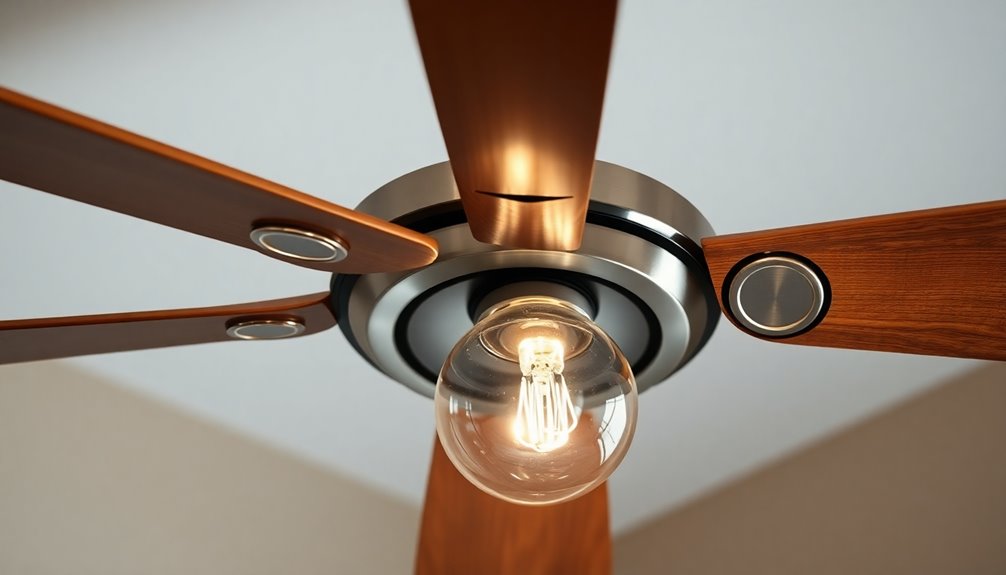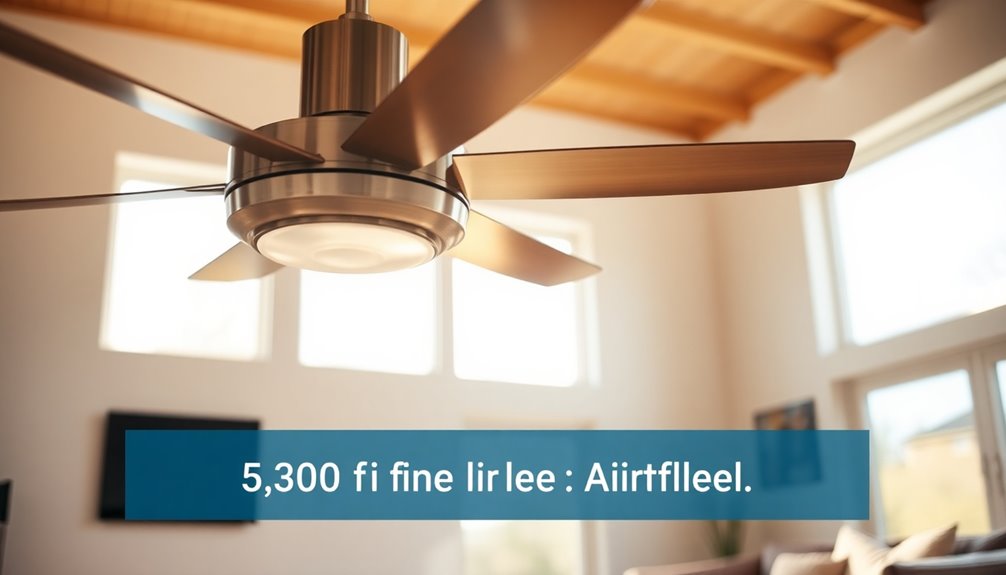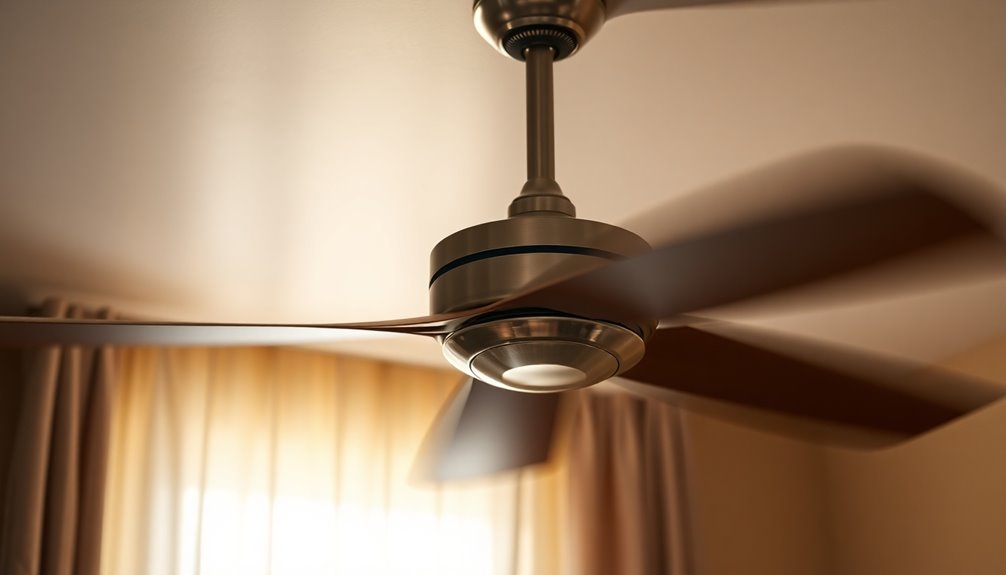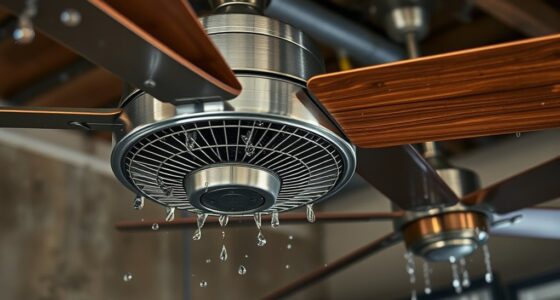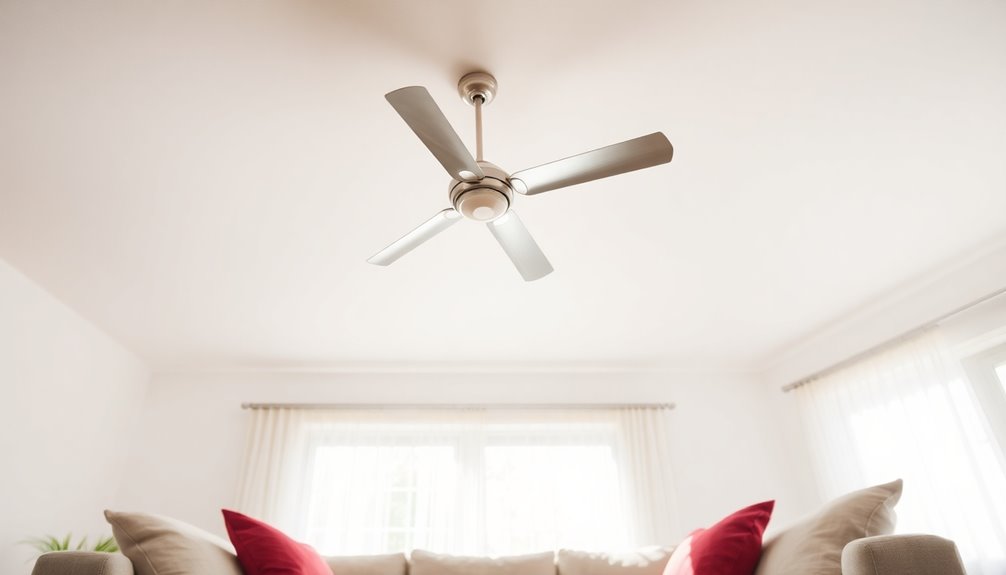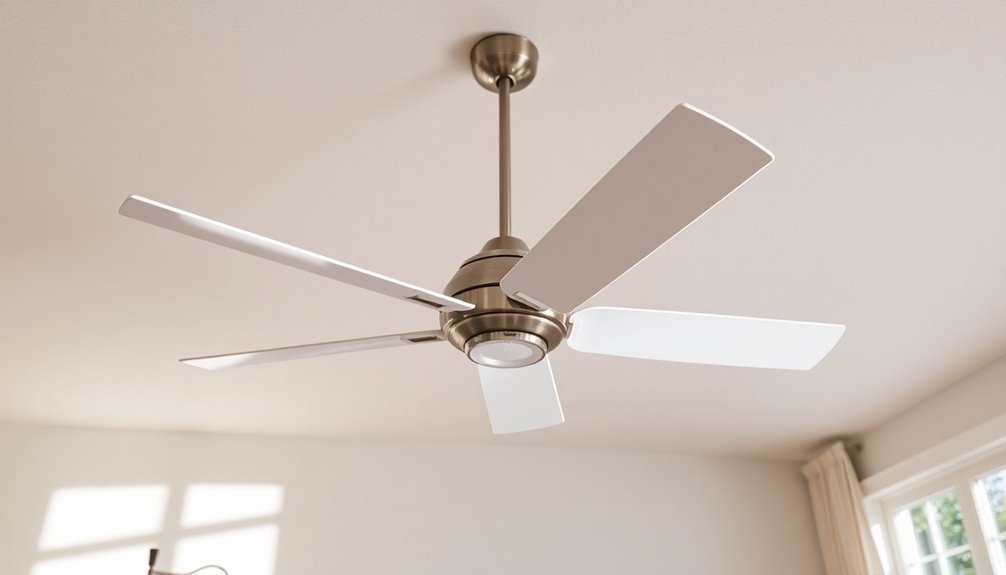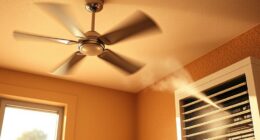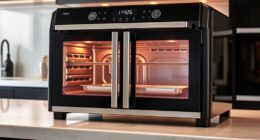When selecting a light bulb for your ceiling fan, you typically want an E26 or E12 base. E26 is standard for many U.S. fixtures, while E12 is common for candelabra styles. For brightness, aim for at least 800 lumens but stay within the maximum wattage specified in your fan's manual to prevent overheating. LED bulbs are a great choice for energy efficiency and long lifespan. Consider the color temperature too; warm white is cozy, while cool white suits workspaces. There's more to choosing the perfect bulb to enhance your space's ambiance and efficiency.
Key Takeaways
- Check your ceiling fan's manual to determine the required bulb base size, commonly E26 (medium) or E12 (candelabra).
- Measure the bulb's diameter in eighths of an inch to ensure proper fit; for example, E26 is 26/8 inches.
- Consider the shape of the bulb; standard shapes like A19 and G16.5 are typically used in ceiling fans.
- Aim for bulbs that provide at least 800 lumens for adequate brightness while staying within the fan's maximum wattage rating.
- Opt for energy-efficient LED bulbs to reduce energy consumption and prolong the lifespan of your ceiling fan lighting.
Types of Ceiling Fan Light Bulbs

When choosing light bulbs for your ceiling fan, you've got several options that can profoundly impact both ambiance and energy consumption. The different types of ceiling fan light bulbs include incandescent bulbs, LED ceiling fan bulbs, CFLs, halogen bulbs, and smart bulbs.
Incandescent bulbs give off a warm, inviting glow, but they're not very energy-efficient, consuming a lot of power compared to their alternatives.
If you're looking for a more energy-efficient choice, LED ceiling fan bulbs are the way to go. They use up to 80% less energy than incandescent options and last considerably longer, making them a smart investment.
CFLs are another option, offering a longer lifespan and consuming about 75% less energy than traditional incandescent bulbs, but they can take a moment to reach full brightness.
Halogen bulbs provide bright light and are relatively efficient, but their shorter lifespan can make them less ideal for ceiling fans.
Finally, smart bulbs offer versatility, allowing you to adjust brightness and color via apps or voice commands, making them perfect for creating the right atmosphere in your space.
Understanding Bulb Base Sizes

When choosing light bulbs for your ceiling fan, understanding bulb base sizes is key.
Common base types like E11, E12, E17, and E26 vary in size and compatibility, so you'll want to check your fixture's requirements.
Measuring the base size accurately guarantees you avoid overheating and potential safety hazards.
Common Base Types
Understanding the different bulb base types is essential for guaranteeing your ceiling fan operates effectively. The most common bulb bases you'll encounter include E11 (Mini Candelabra), E12 (Candelabra), E17 (Intermediate), and E26 (Medium). Among these, the E26 medium screw base is the standard for many ceiling fan light fixtures in the U.S.
Here's a quick reference table to help you understand these bases:
| Base Type | Description | Common Usage |
|---|---|---|
| E11 | Mini Candelabra | Smaller fixtures |
| E12 | Candelabra | Decorative applications |
| E26 | Medium | Larger ceiling fan lights |
When choosing a bulb, always check the specific base type required for your ceiling fan fixture. Older models may use different base types, and mismatched sizes can lead to installation issues. For peak performance, make sure the bulb size matches the shape and dimensions specified in the ceiling fan's manual. This guarantees your ceiling fan operates smoothly and efficiently.
Size Measurement Standards
Choosing the right light bulb for your ceiling fan hinges on knowing how to measure and identify bulb sizes accurately.
Light bulb sizes are denoted by a combination of letters and numbers. The letters represent the base type, like "E" for Edison, while the numbers indicate the diameter in eighths of an inch. For example, E26 means a medium base with a diameter of 26/8 inches.
Common base sizes for ceiling fans include E11 (mini candelabra), E12 (candelabra), E17 (intermediate), and E26 (medium). The E26 base is the standard for many ceiling fan fixtures in the U.S.
Additionally, bulb shapes like A19 (standard), T12 (tubular), and G25 (globe) categorize light bulb sizes based on specific dimensions and designs suited for different fixtures.
Accurate measurement of light bulb size is vital for compatibility with your ceiling fan's light kit. Incorrect sizes can lead to improper fit and potential damage.
To guarantee you select the correct bulb, consult a light bulb size chart, confirming both the base size and wattage limits specified by your ceiling fan's manufacturer.
Compatibility With Fixtures
Knowing the right bulb size is only part of the equation; compatibility with your ceiling fan's fixtures is equally important.
You need to check the specific bulb base type required by your fan. Common base sizes include E11 (Mini Candelabra), E12 (Candelabra), E17 (Intermediate), and E26 (Medium), with E26 being the most prevalent in the U.S. Each bulb base size corresponds to a diameter measured in eighths of an inch, so E26 indicates a diameter of 3.25 inches.
It's crucial to ascertain that the shape and size of the bulbs, such as A19 or G25, align with the fixture specifications. If they don't match, you could face installation issues.
Additionally, always refer to the manufacturer's guidelines for maximum wattage limits and recommended bulb types. Exceeding the maximum wattage can lead to overheating and potentially damage your fixture.
Importance of Lumens and Wattage

When you're choosing light bulbs for your ceiling fan, understanding lumens and wattage is essential.
Lumens tell you how bright a bulb will be, while wattage indicates how much energy it consumes.
Striking the right balance between brightness and efficiency guarantees you get the best performance without compromising safety.
Understanding Lumens Measurement
Often overlooked, understanding lumens and wattage is essential for achieving ideal lighting in your ceiling fan. Lumens measure the brightness of a light bulb, so when you choose a bulb, look for the lumen output that fits your room size and purpose.
For example, if you need brighter areas, consider bulbs that emit 1,000 lumens or more.
Wattage, on the other hand, indicates how much energy a bulb consumes. Traditional incandescent bulbs, like a 60-watt option, typically produce around 800 lumens.
However, energy-efficient LED bulbs can generate the same brightness with considerably lower wattage. A mere 10-watt LED can achieve those same 800 lumens, showcasing the efficiency of modern lighting technology.
Selecting Appropriate Wattage
Selecting the right wattage for your ceiling fan is vital for achieving both ideal lighting and energy efficiency. The brightness of a light bulb is measured in lumens, and for effective main lighting, you should aim for bulbs that provide 800+ lumens. To save on energy costs, consider using LED ceiling fan light bulbs with lower wattage, such as 8-9W, which can match the brightness of traditional 60W incandescent bulbs.
Here's a quick comparison of wattage and lumens:
| Wattage (W) | Approx. Lumens |
|---|---|
| 8-9W | 800 |
| 13-15W | 1100 |
| 18-20W | 1600 |
It's important to adhere to the maximum wattage specified by your ceiling fan fixture to prevent overheating, which can damage the fan and create safety hazards. Additionally, opting for dimmable bulbs gives you flexibility, allowing you to adjust brightness levels according to your needs. Always verify that your chosen bulb's wattage is compatible with your ceiling fan's specifications, especially if you have an older model.
Balancing Brightness and Efficiency
Finding the right balance between brightness and efficiency is vital for maximizing your ceiling fan's lighting. When selecting bulbs, keep in mind that lumens measure brightness, while wattage indicates energy consumption. A standard 60-watt incandescent bulb produces about 800 lumens, which is a decent brightness level.
However, you can achieve the same brightness with an LED bulb that uses only 8-9 watts, leading to significant energy savings.
For ceiling fans serving as the primary light source, aim for bulbs that provide 800 lumens or more. This guarantees your space remains well-lit without compromising efficiency. Opting for lower wattage options not only enhances lighting efficiency but also helps you save on energy bills over time.
It's essential to adhere to the maximum wattage specified for your ceiling fan fixture, typically not exceeding 60 watts for incandescent bulbs.
Choosing the right balance of lumens and wattage will enhance your ceiling fan's performance while promoting safety and longevity. By making informed choices, you'll enjoy both ideal brightness and energy savings, creating a comfortable and cost-effective environment in your home.
Choosing the Right Color Temperature

Choosing the right color temperature for your ceiling fan light bulbs can greatly impact the mood and functionality of your space. Color temperature is measured in Kelvins (K), and different values create distinct atmospheres. For example, warm white bulbs (2700K-3000K) produce a cozy glow, perfect for living rooms and bedrooms, while cooler temperatures (5000K-6500K) mimic daylight, making them ideal for task-oriented areas like kitchens and workspaces.
When selecting LED bulbs for your ceiling fan, consider how the color temperature aligns with the room's purpose. Here's a quick reference table to help you choose:
| Color Temperature | Description | Best Used In |
|---|---|---|
| 2700K-3000K | Warm White | Living Rooms, Bedrooms |
| 3500K-4100K | Cool White | Kitchens, Workspaces |
| 5000K-6500K | Daylight | Offices, Garages |
Dimmable Lighting Options

Dimmable lighting options for your ceiling fan can transform the atmosphere of any room, allowing you to create the perfect ambiance for different occasions.
With dimmable bulbs, you can easily adjust brightness levels to suit your needs, enhancing your ceiling fan's versatility. When selecting these bulbs, make sure they're compatible with your fan's dimmer switch, as not all bulbs support dimming features.
LED dimmable bulbs are highly recommended for ceiling fans. They're energy-efficient, have a long lifespan, and provide consistent light output without flickering.
Typical dimmable options include LED, incandescent, and some CFL bulbs, but LED bulbs lead in energy savings and longevity.
Before making a choice, it's essential to check the maximum wattage rating of your ceiling fan fixture. Exceeding this limit can lead to overheating and potential damage, so be mindful of the wattage when using dimmable bulbs.
Installation and Maintenance Tips

When it comes to enhancing your ceiling fan's lighting, proper installation and maintenance are key to ensuring longevity and ideal performance. To get started, always turn off the power to the ceiling fan at the circuit breaker before replacing or installing light bulbs. This keeps you safe and prevents any electrical mishaps.
Here are some essential tips for installation and maintenance:
- Check wattage: Always verify the fixture's maximum wattage rating to avoid overheating and damage to both the fan and bulbs.
- Use proper tools: Employ a ladder or step stool to safely reach your ceiling fan when changing bulbs.
- Regular cleaning: Dust buildup on bulbs and light fixtures can reduce brightness and efficiency, so make it a habit to clean them regularly.
Lastly, consult the manufacturer's guidelines for specific maintenance tips and recommendations on compatible bulb types for your ceiling fan model.
Following these steps won't only enhance the lighting in your space but also extend the life of your ceiling fan.
Recommended Light Bulbs for Fans

Selecting the right light bulbs for your ceiling fan can greatly impact both the lighting quality and energy efficiency of your space. Most ceiling fans use either a medium base (E26) or a candelabra base (E12) light bulb, so it's essential to check your fan's specifications for compatibility.
For ideal brightness, aim for a bulb with a lumen output of at least 800 lumens, which will serve well for main lighting.
LED bulbs are your best bet for ceiling fans, as they use up to 80% less energy than incandescent bulbs while delivering equivalent light output. When choosing LED bulbs, make sure they fit within the maximum wattage specified in your fan's manual—typically around 60 watts for incandescent and 9-14 watts for LED.
Common bulb shapes that work well in ceiling fans include A19 and G16.5, with the A19 being the most prevalent size.
Frequently Asked Questions
What Size Light Bulb Do Ceiling Fans Take?
When choosing a light bulb, you need to contemplate the base size, wattage, and bulb shape.
Most fixtures use bases like E12, E26, or E17, with E26 being the most common. You'll typically find A19 bulbs fit well, but other shapes may work too.
Always check the manufacturer's wattage limits, and verify the bulb type is compatible with your fixture to achieve the best lighting and efficiency for your space.
Are A19 and E26 the Same?
You might think A19 and E26 are the same, but they're not. A19 refers to the bulb's shape and size, while E26 describes the base type.
It's like having a puzzle piece that fits perfectly but has a different picture. When you're selecting a bulb, remember that A19 bulbs usually come with E26 bases, making them a popular combo.
Always check compatibility to avoid any surprises when you're ready to light up your space!
How Do I Tell What Size Light Bulb I Need?
To figure out what size light bulb you need, start by checking the bulb socket's size and type. Measure it with a ruler, noting any specifications.
Look for the recommended wattage to avoid overheating. You can also consult a light bulb size chart for help.
If you're still unsure, refer to the manual or manufacturer's guidelines for more details on compatible bulb sizes and shapes that'll work best for your needs.
Can I Put a 60 Watt LED Bulb in a 40 Watt Ceiling Fan?
Are you willing to risk overheating your ceiling fan?
You can't put a 60-watt LED bulb in a fixture rated for just 40 watts. Even though LED bulbs use less energy, exceeding the wattage limit can lead to damage and safety hazards.
Always check your fan's manual for wattage recommendations. Stick to the specified limits to guarantee your fan runs safely and efficiently, avoiding potential fire risks and extending its lifespan.
Conclusion
Ultimately, choosing the right light bulb for your ceiling fan can enhance both functionality and ambiance in your space. Did you know that about 80% of ceiling fans come with built-in lighting, but many users overlook the importance of selecting the right bulb? By considering types, sizes, and color temperatures, you can create the perfect atmosphere while maximizing energy efficiency. So, take a moment to pick the ideal bulb and enjoy the benefits it brings to your home.
